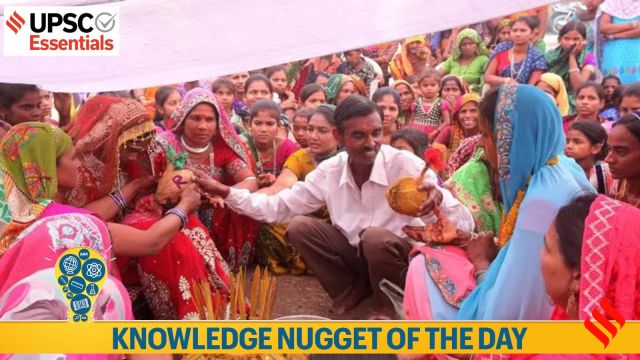Key Takeaways:
1. The ‘Nata Pratha’ tribal custom is practiced in the predominantly tribal areas of Salumbar Banswara, Dungarpur, Pratapgarh, Udaipur, Sirohi, Rajsamand, Pali, and Chittorgarh. The custom allows for a woman to formally declare before the village panchayat that she is leaving her spouse to live with another man.
2. The tribes in the village of Surkheda, Gujarat have a different marriage custom. According to the custom, the bridegroom must stay at home on his wedding day while his unmarried sister stands in to perform the wedding rituals conducted at the home of the bride. The sister’s role concludes as soon as she reaches her home and hands over the bride to her brother.
3. In the Garasia tribe of Rajasthan, couples stay together and only hold weddings when they have enough savings. Among Jaintia tribes, the married couple lives with the bride’s parents. Among the Andaman tribes, daughters are the heirs of their parents. The Murias permit boys and girls to live in the ‘ghotul’ (youth dormitory) before they choose their life partners.
Story continues below this ad
4. Jatapus tribes of Andhra Pradesh who mainly reside in forest and hill areas in Vizianagaram district also have a unique tribal custom of marriage. According to the website of the Andhra Pradesh government, there are several forms of marriage followed in the community. “The practice of the matrimonial customs are one is the parents of the bridegroom along with elders of the Village has to go to the bride’s houses and ask “water to wash the legs”. If the bride/her parents are willing to perform matrimonial relations, they offer water to them, otherwise they won’t.”
5. Among the Mannans tribe of Kerala, Jacob John Kattakayam writes, ‘Marriage by service’ was the most common form of marriage. In this custom, service was rendered by the boy for a period of one to six months. During that period he lived in the house of the girl and participated in household chores and agricultural labour. The girl’s parents took this opportunity to assess the talents and temperament of the boy. If they were satisfied, they accepted the marriage proposal.
6. Among the Bhils tribe of Madhya Pradesh, there is a custom of fixing a bride price before the marriage. In the Garo tribes of Meghalaya, once the girl chooses who she has to marry, the boy is abducted and confined to a separate space. If he runs away, he is permitted to marry someone else.
7. Several tribes, including the Gonds, Bhils, Oraons, Mundas, and Santhals, practise bigamy. Polyandry has always been a custom among the Garo, Gaddi, Galong, and Jaunsar Bawar tribes, and it is said to be phased out gradually.
|
Polyandry and Polygamy Story continues below this ad |
| Polyandry is a practise in which one woman has more than one husband or male partner. Polygamy is the practice of having more than one married spouse — wife or husband. IPC Section 494 (BNS Section 82) penalises bigamy or polygamy. The NFHS-5 showed the prevalence of polygamy (the percentage of women who reported their husbands had other wives) was highest among Christians (2.1%), followed by Muslims (1.9%), and Hindus (1.3%), looking at religion. Overall, Scheduled Tribes reported the highest incidence at 2.4%. |
8. Among Mundas, Santhals, Oraons, Gonds, Kols, Korkas, Bhils and some other tribes of the North-east and South and West India, daughters have no right on property but they are given compensation for living, like widows, if they need it. The youngest daughter in the Garo tribe becomes the heir of the family and her husband comes to her house to live.
BEYOND THE NUGGET: Pradhan Mantri Awas Yojana

1. According to government sources, nearly 5-10 percent of the 1.58 lakh houses sanctioned under the PMAY in these areas are stalled because of the widely practised Nata Pratha custom. This assumes particular significance when the Rajasthan government is conducting a drive to identify more eligible beneficiaries under the scheme.
2. The Pradhan Mantri Awas Yojana was launched by the Narendra Modi government in 2015 in place of the Indira Awas Yojana. It is a credit-linked subsidy scheme to help provide affordable housing. Under the scheme, beneficiaries are identified through a three-step verification process that involves taking into account the Socio-Economic Caste Census (SECC 2011) and a 2018 Awas survey, gram sabha approval, and geo-tagging.
3. Financial assistance of Rs 1.20 lakh (in plain areas) and Rs 1.30 lakh (in hilly/inaccessible areas) is sent to the Aadhaar-linked bank accounts of identified beneficiaries, who must fulfil 10 conditions — including not falling within the tax bracket, not owning vehicles and not owning more than five acres of land.
Story continues below this ad
4. Women are primary beneficiaries under the scheme, meaning that, under the rules, they must either be listed as the sole owner or the joint owner of the house being built under the scheme, except when there is no adult woman in the family.
Post Read Question
(1) Every year, a month long ecologically important campaign/festival is held during which certain communities/tribes plant saplings of fruit-bearing trees. Which of the following are such communities/ tribes? (UPSC CSE 2014)
(a) Bhutia and Lepcha
(b) Gond and Korku
(c) Irula and Toda
(d) Sahariya and Agariya
(Source: Amid Sangh Parivar’s long push for UCC, concerns over tribal blowback loom large, Development’s new ally in tribal India: Sabka Vikaas, Sabka Vivaah, Art and Culture with Devdutt Pattanaik | Contribution of tribes to Indian culture)
Subscribe to our UPSC newsletter. Stay updated with the latest UPSC articles by joining our Telegram channel – IndianExpress UPSC Hub, and follow us on Instagram and X.
Story continues below this ad
🚨 Click Here to read the Union Budget Special issue of the UPSC Essentials magazine for February 2025. Share your views and suggestions in the comment box or at manas.srivastava@indianexpress.com🚨



































